Daily Updates
Daily Updates for the 2003 GLOBE Learning Expedition
Click on the date to see the update for that day.
Daily Update: June 29
Enthusiastic Delegates Arrive for the 2003 GLOBE Learning Expedition
by Herma Percy-McDaniel
Hundreds of students, teachers and scientists from around the world are gathering at the 2003 GLOBE Learning Expedition (GLE) in
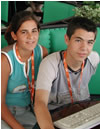
Šibenik, Croatia. The GLE kicks off today with an opening ceremony with remarks from the Croatian Ministry of Education and Sports and a welcome reception hosted by the Mayor of Šibenik, Milan Arnautovic. The theme for the GLE is "local discoveries, global understandings."
This week the students will present their research projects that will showcase their use of Earth Science data. Students will also have a day of fieldwork at Krka National Park and on the island of Obonjan. The GLE will give students an opportunity to experience and take measurements in a new environment and learn from each other and GLOBE scientists.

Participants include approximately 400 students and teachers from 23 countries. Participating countries are Argentina, Bahrain, Cameroon, Canada, Croatia, Cyprus, Czech Republic, Egypt, Estonia, Finland, Germany, Hungary, Island, Japan, Lebanon, Norway, Poland, Qatar, Spain, Switzerland, Thailand, UK and USA.
The GLE is co-sponsored by the United States and the Croatian Ministry of Education and Sports. The Croatian co-organizers include the Ministry of Environmental Protection and Physical Planning, Ministry of Foreign Affairs, Ministry of Defense, Ministry of Internal Affairs, Sibensko-Kninska County, City of Sibenik, City of Zagreb, and Krka National Park.

The GLOBE Program will provide daily website updates of GLE highlights from June 30th to July 4th.
Students will report on various GLE activities and research projects.
Daily Update: June 30
Student Presentations Begin Today!
The first session of student research presentations started today with about 48 presentations from
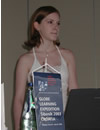
various grade levels around the world. Student research projects covered a wide range of topics and demonstrated the hard work of many students. Student projects were presented by student groups from Argentina, Bahrain, Croatia, Cyprus, Czech Republic, Estonia, Germany, Hungary, Lebanon, Norway, Switzerland, Thailand, and the United States of America.
For details on these student projects visit the Student Reports page.
Students from Croatia take a look at "The Influence of Changes in Climitic Elements on our Health''
by Josipa Kralj

The School for Nurses Vrapce – Zagreb (Croatia) research project on weather and health consisted of two interrelated studies. The first study was conducted during March and May of the school year 2000/2001, and the second one during the same period of the school year in 2001/2002. The research was conducted in their school with 60 students and a senior citizen's home with 75 adults. In the first project they started from the presumption that climatic elements (temperature, air pressure and humidity) affect the cardiovascular system, meaning the blood pressure and blood circulation; changes in blood pressure are caused by dilatation and contracting of blood vessels and this is interconnected with the flow of blood influencing the supply of their tissues by oxygen and glucose; the nervous system is the first to react to such changes of oxygen and glucose concentration. They wanted to find out to which extent people are really sensitive to weather changes, and to which extent manifestations (headache, fatigue, low concentracion, dizzines and bad mood) can be traced back to subjective evaluation. The results of their first research confirmed some of their hypothesis.
In the second research they asked the following research questions: How will the age group of seniors (retired people above the age of 60) respond to abrupt changes of climatic elements. Their hypothesis was that their blood vessels are even less adaptable to abrupt changes of air pressure, air humidity and air temperture. Students calculated the percentage of dizziness, headache, fatigue, lack of concentration, bad mood occurence as well as the daily blood pressure for each age group. The student researchers found out the rise of the air humidity causes dizziness (when humidity is above 85%), more with the teachers, less with the students. Abrupt changes of climatic elements are more dangerous for our organism than the their extreme absolute values. In both groups it was detected that small fall of air pressure results in fall of systolic blood pressure. Systolic blood pressure of the mature group is somewhat higher (between 115-125 mmHg), than of the young group of students (106-120 mmHg), without any spectacular changes. Diastolic blood pressure oscillates even less, and the average value for teachers is 75 mmHg, and for the students 70 mmHg. The study also concluded high daily amplitudes of temperature cause high blood pressure, affecting in particular the elderly.
The student researchers were M. Mokrovic, M. Grgic, N. Baric, M. Tuta, M. Gagulic, J. Grgic, T. Bencevic and A. Jurkovic.
Project: Are the pine forests around Labin dying?
by Marin Scira
Our team comes from Istria, Croatia. Istria is a peninsula north of Sibenik. We investigated the
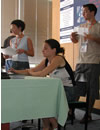
condition of the pine woods in the area of city of Labin. Labin municipality is a area than includes different, specific locations. Some of these areas were used for our project. Our research was based on the investigation of pine trees, but many other factors that directly influence their condition. This includes the influence of the nearby power plant and the position of the roads, but also the maintenance of the areas. The analysis was done using GLOBE and UNESCO-SEMEP protocols. About 500 trees were visually inspected with the instructions of the Forestry Institute from Zagreb. The inspection included looking for any damage on the trees or any presence of the pine moth. Seven locations were visited of which four included black pine and three aleppo pine trees. All locations are covered with a submediterannean soil type. Charts were created from the field data and presented. Depending on their position and their maintenance, different degrees of damage and infection of pine moth were found. The soil analysis showed that the soil was mainly clay and shallow with low porosity and acidity, with small quantities of nourishment which resulted in it being barren. Harmful supstances, either weren't present or were in small quantities so that they could have any real negative influence. The analysis of pine needles based on three samples showed that larger amount of supstances that could negatively effect the trees wasn't present or was in very small quantities. Similar results came out when data for the atmospheric influence was collected and analysed. This project had more than one goal. It helped students in developing their skills and acquiring more knowledge, but hopefully it will urge the responsible authorities in taking better care of our most prized possession, nature. The conclusion was that the forests are not dying at the present moment, but they should be preserved better in the future, for the man but also against the man.
Factors Affecting Maximum and Minimum Atmospheric Temperatures
by Kathy Carbonell
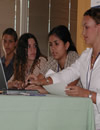
The GLOBE Team from the island of Puerto Rico (U.S.) delivered their presentation today on the factors affecting maximum and minimum air temperature. Team members Tanya Casiano, Pamela Gonzalez, Jessica Cestero, and myself began our research in early September of the year 2002. We began observing GLOBE data of two separate sites the western coast of the island and noticed a continuous pattern in air temperature that immediately caught our eye. One of the sites, located in the city of Mayaguez, had a greater maximum temperature and lower minimum temperature than that of the site, located in city of Ramey. We brainstormed possible factors that might be causing such an extreme temperature range. The distance between the two sites is only about 32 miles. We eliminated the factors that GLOBE data proved insignificant (such as cloud coverage) and were left with soil moisture, the heat island effect, elevation, topography and wind speed and direction. Our collection of soil moisture data showed that the Mayaguez site actually had greater soil moisture. We found this odd because we would expect soil with greater amounts of moisture to be less liable for such an extreme temperature range. Other sources informed us that because the two sites had such a close proximity to the ocean, it created a buffer effect and therefore soil moisture would not be reliable when dealing with atmospheric temperature. For the heat island effect, we used satellite photos of the two areas to calculate the percentage of concrete coverage. Although there proved to be little difference percentages, recent development in the Mayaguez area is a possible growing factor in their greater maximum temperatures (something developing regions should be aware of: the more concrete, the greater the heat!). However, what we found to be the greatest influencing factors were actually elevation, topography, and wind speed and direction. The Mayaguez region is surrounded by a mountain range (La Cordillera Central) that runs through the center of the island. These mountains (elevation of about 850 meters) block the Global Trade Winds during the day coming from the northeast, not allowing any wind to penetrate the area. Ramey, however is not affected by these mountains and has cool breezes all day long. Then how could Mayaguez possibly have cooler temperatures as well? At night, the Trade Winds die down, allowing for the cool mountain breezes to cool the area; and because the mountains surrounding Mayaguez are at greater elevation than any near Ramey, these breezes account for the cooler air temperatures experienced in that area. Although all of our researched factors contributed to our investigation, the elevation, topography and wind proved to be the most influential for the greater maximum and lower minimum temperatures of Mayaguez, Puerto Rico. Because there is no wind protocol, we had to rely on our qualitative knowledge of the winds in the two areas; but we are hoping GLOBE will devise a new wind protocol so that we may continue further research!
Daily Update: July 1
Visit to Krka National Park
On Tuesday GLE participants went to the Krka National Park in Sibenik. The park was a beautiful
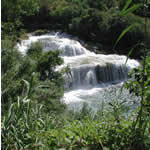
measurement site with cascading waterfalls and bridges over crystal clear streams. The participants were taken to the Krka National Park by buses. Students were organized into groups, and each group received a research area map with marked sites for measurements to be carried out according to the GLOBE protocols.
"It was a good site because differences could be expected on the waterfall by measurements of the upper and lower levels of the fall. In a small area many different rivers flow to the canyon and on the upper part of the canyon the atmosphere soil conditions and vegetation are different, and at the bottom of the canyon within the river are differences as well,'' said Vladimir Kusan, Croatian GLOBE Scientist.
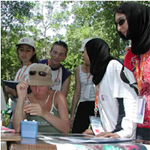
Students expressed their excitement with the site in video interviews conducted by GLE student reporters. Visit the GLE Webcast Page for this and other video from the conference.
Daily Update: July 2
Visit to Obonjan Island
The GLOBE Program took the GLE activities outdoors again on Wednesday with a visit to the island of
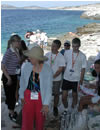
Obonjan. Scientists, teachers and students enjoyed a full day of student measurements on the island which began with an exciting boat ride on a navy vessel. Various participants shared their thoughts with us about the experience:
"It was a really nice experience. Students learned about microorganisms of the sea. I believe the students really learned a lot about a protocol that is not one of the protocols in GLOBE."
Fatin Ahmed-Teacher
Bahrain
"It was a really great site because students do not have the same environment in their country. It was a different site so students learned different things. For example, Thailand is a different country so we were able to learn more about another country."
Somsri TangmongKollert-Country Coordinator
Thailand
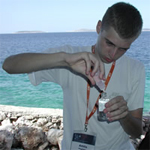
"I learned a lot about hydrology. Site J was interesting because we collected sea organisms. We were able to dive and collect organisms. It was very interesting."
Josipa - Student
Croatia
I did soil testing for the first time because usually I strictly focus on hydrology. I also did land cover testing for the first time.
Sim Batth - Student
USA
"The best part of the experience was the diving."
Tomas – Student
Czech Republic
"I didn't realize how clean the Croatian waterway was until our visit to Obonjan."
Arminther Bal
USA
GLOBE Scientist, Vladimir Kusan of Croatia summarized the purpose of the visit to Obonjan by pointing
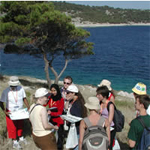
out the site was a great learning place for students. "I believe the students were able to learn about different types of vegetation. They learned about the soil such as where the soil is beginning to grow, and discovered different kinds of soil and the structure of it. With the atmosphere measurements students could measure different parameters and discover whether they are different between the northern and southern part of the island, and the influence of the sun and wind on the eastern and western part of the island." He also added the site was great for learning because "it had very nice pine forests surrounding the island and sparse vegetation, which influence the quality of air and the different types of soil."
Daily Update: July 3
Our Favorite Day at the GLOBE GLE
by Amanda Krieger and Bethany Shelly
We have been in Croatia for five days now. The day we remember as our most favourite day was the day
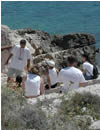
we went to Obonjan Island. On July 2nd, we all boarded a Croatian Navy cruiser to go to the island. At first we thought, "Oh, Cool! We are riding on a Navy ship!" Later, we found out that it was scorching hot inside the boat! Luckily, we could go up to the top deck, and the view of the Adriatic Sea was breath-taking! After we arrived, we went to a variety of sites. We were on different teams, the Snails team and the Octopus team, so each of us went to different sites. We learned how to do environmental measurements at the Hydrology site, including water temperature, salinity, and turbidity. At the atmospheric site, we learned about recording minimum and maximum temperatures. At one of the sites, one of the leaders would go snorkelling and bring up marine animals to show to us. At the Geology site, we learned about the fossils in the rocks at the edge of the sea. We both went to the Land Cover and Soils site. We learned about what the texture of the soil and what it is made of, what kinds of plants are on the island, and how to use GPS to find our location.
We both really enjoyed the beach. We stayed on the beach, swam, sunbathed, and just stared at the beautiful water. We went to the restaurant on the island for lunch. We ate outside and the bees were very annoying. There were too many of them! We went back to the beach and spent the rest of the time chatting and joking with each other. What a nice way to spend our day!
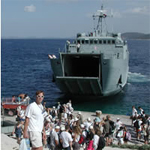
We are both from Indiana in the United States of America. We have noticed a lot of differences between Indiana and Croatia. One of the differences is that the time in Croatia is seven hours later than in Indiana. We had jetlag after we arrived and we were sure tired! Here in Croatia, the temperatures have been between 95-100 degrees F, but in Indiana temperatures are between 85-90 degrees F. Another example is that in Indiana, most boys wear swim shorts that reach their knees, but in Croatia, the swim suit in style is the Speedo. Here in Croatia, bread is served with every meal, no matter where we go. Their breakfast foods are more than simple than ours with cereals, fruit, thinly cut meats, and cheese, while our breakfasts in Indiana are often served with large portions of food that include eggs, bacon, sausage, toast, pancakes, or cereals.
We have enjoyed learning about the people of Croatia, the differences in our culture, and their beautiful country.
Daily Update: July 4
Highlights of the GLE Week and the Closing Ceremony
There were numerous opportunities during the week for each country delegation to represent their
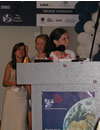
country's culture, traditions and customs. All GLOBE countries attending the GLE participated in a poster exhibit. Exhibits depicted the GLOBE program in their country and highlighted unique historical, environmental, and cultural aspects of their country. Posters were featured on panel boards throughout the duration of the GLE for conference attendees to read information and ask questions.
GLE participants joined in for additional cultural presentations such as the cultural dances. On Monday, Tuesday, and Wednesday students expressed their culture and traditions with indigenous dances. The cultural dances were fun ways for students to teach others around the world about their heritage. The event was a
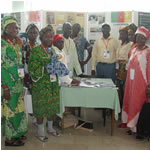
great bonding experience among participants from different nations and cultures.
Another expression of culture was a presentation about the history of Sibenik. Their was discussion of the places that were ruined by the war and the areas that are being rebuilt. Presentation of Sibenik also included the various ways people, including students, were helping to rebuild Croatia.
On Friday, the program started with presentations of the Krka and Obonjan field research results. The research results were presented and interpreted by the students and the field research team members. At the closing ceremony awards of certificates were given to GLE participants. Many people expressed their delight with another successful GLE and are already looking forward to another GLE.
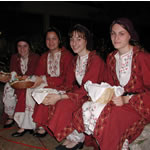
My GLE Experience
By Kristen B. Suiter
Being young, the students of our group are curious about many things around us, and that's how we landed in a GLOBE Learning Expedition. Being Deaf isn't as tough as people might think! Deaf people manage to go to places all over the world. We dream big and we believe that the sky is the limit. GLOBE has been a big part of our dreams. The GLOBE program made that dream come true when they chose us to come to Croatia.
GLOBE gave us an opportunity to show and present the hard work we did in our Earth system science class. We feel that we couldn't have done a better on our project because we gave it our best. We also feel very proud of our work. We are thrilled about being able to meet various people from all over, learn from their cultures and projects, see what a scientist's work is like, and experience living the scientific
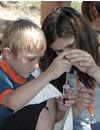
life. It was great when we were able to do different kinds of fieldwork and we were able to do it in such a beautiful place as Krka National Park and on Obonjon Island! It was especially a refreshing experience to swim in the Adriatic after doing the fieldwork on the island and Krka National Park.
We find it hard to believe that this week with GLOBE is over. We're not looking forward to the end!





